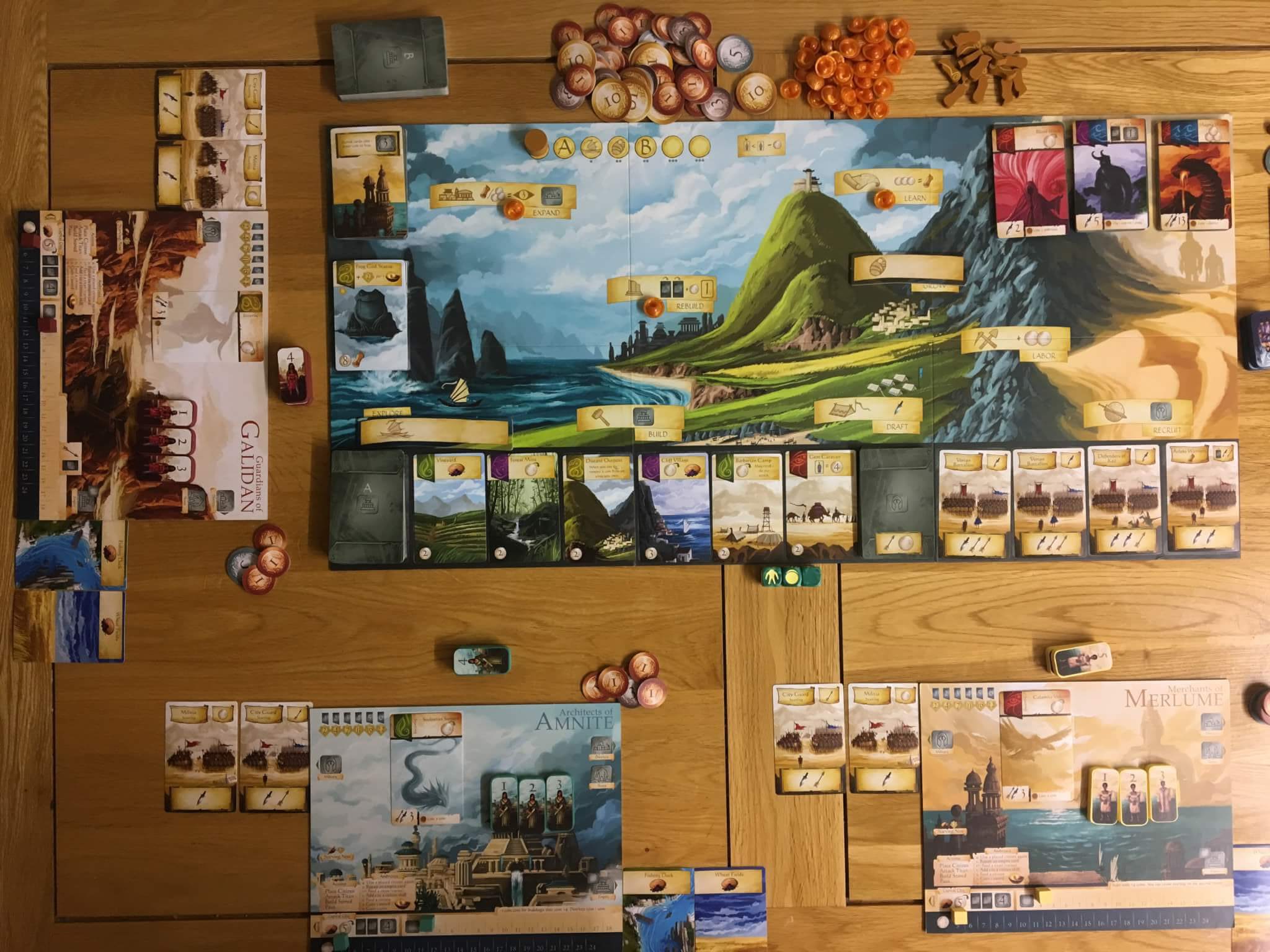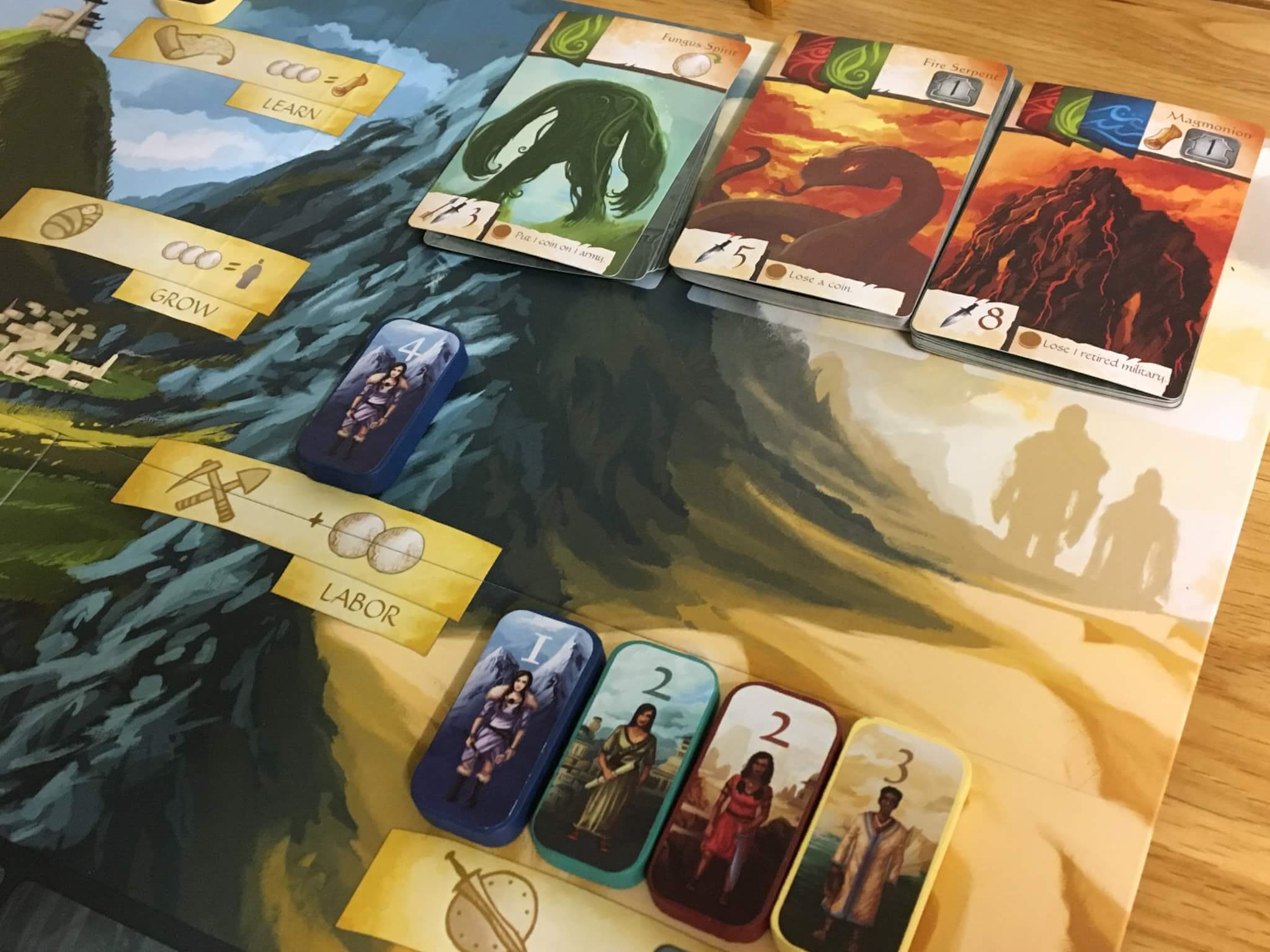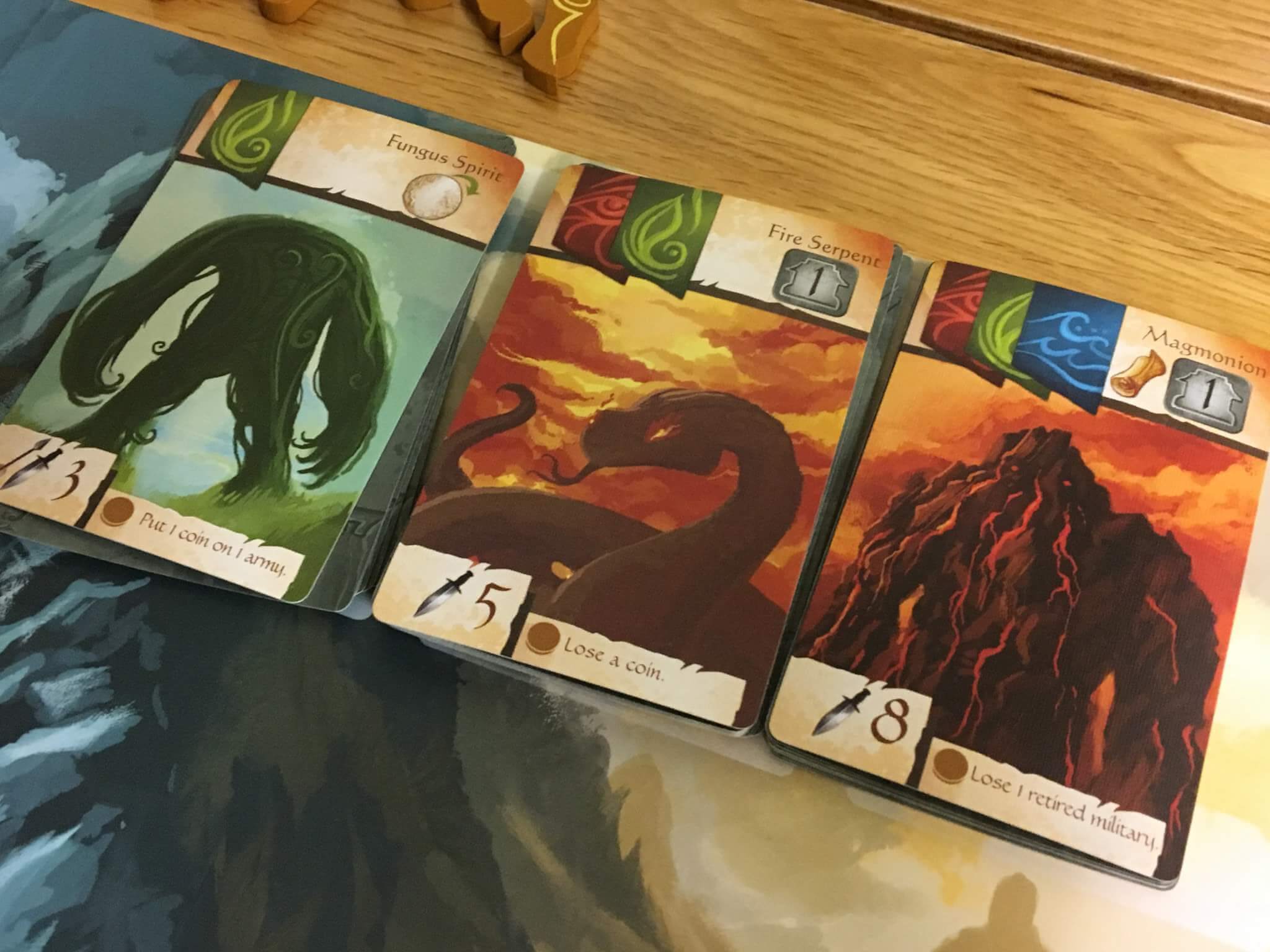In Ryan Laukat’s The Ancient World: Second Edition, each player will take control of a city state vying for the attention of five migratory tribes, fleeing from rampaging titans. To do this, each city must be bigger, better equipped and better provisioned than its neighbours. By taking the battle to the titans directly even more glory can be obtained. Will you master The Ancient World?
First things first, The Ancient World: Second Edition is obviously a remake, but since I have never played the original, I can’t really comment on how much of Laukat’s 2014 game is retained here. The list of revisions (referred to in the designer’s notes) includes the addition of a new resource (Ambrosia) and a more direct threat from the titans, among a few other lesser changes. Whilst the amendments sound fairly subtle, having played The Ancient World: Second Edition several times, I could imagine how each one would make it feel materially different.

The five tribes that players are hoping to impress each act like a set collection mechanic that becomes the main source of victory points in the game. Each tribe has its own banner, and each of the cards from two different sources (mostly titan and empire cards) provide one or more banners in specific colours. The intention of the players will be to collect sets of these banners, with each set worth an increasing number of points depending on how many banners you have (up to a maximum of six.)
There are some direct sources of victory points that come from elsewhere, but these are relatively few and far between and come at a significant cost when you do find them. The empire and titan cards that add banners however, almost always come with one or more other beneficial effects that actually improve your city — in turn making it more powerful from one round to the next. Players will balance the need to collect banners with the need to increase their overall power level (which in turn allows them to collect banners more effectively) with each action.
In case you haven’t guessed it, in addition to set collection, The Ancient World: Second Edition is also a tableau building game. Each city state begins with a few coins, a basic food and cash income and an empire size and military limit, as well as some basic military units. Each is already beset by a relatively weak titan when the game begins, and one of the first things you’ll do is work out how to defeat that titan in order to prevent it from damaging the city when the round ends.

Each round comprises of three to five turns per player (unless something goes drastically wrong) and actions are selected by — surprise — worker placement, the third and final key mechanic. Each city begins with three workers of strength one, two and three. When placed on an action space, the player will take the associated action, and if there is a worker already there (whoever owns it) of a higher value, then the player placing the lower ranked worker must pay one gold.
After each player has taken all of their actions (including fighting titans and building empire cards that have previously been reserved, both of which are free) the round ends. After six rounds, the game ends. At the beginning of most rounds a new feature is introduced — in round two for example, the explore action is enabled, whilst in round three, the grow action comes online. In parallel, more and more powerful titans will attack the players, whilst the options for expanding each city state will grow more powerful.
One of the first things that I noticed (and continue to like) about The Ancient World: Second Edition, is the fact that these actions feel generous, even as the game ramps up its difficulty level rapidly. I don’t want to waste your time walking through every single action exhaustively since the manual is exceptionally well written, but to take a couple of examples, let’s have a closer look at recruiting units and expanding your city.

When recruiting, the player will place a worker onto the board and then choose any of the face up military cards. Very few military cards have a cost, and those that do are much more powerful on average than the free ones. What you will find is a limit on how many military units you can accommodate, and when this is reached, you’ll need to retire a unit. When this happens, you flip it over and slide it under another, still active unit. Each retired unit will add a benefit to the unit it is under — which represents the knowledge being passed down among the soldiers.
Not only does this make sense, and feel like a constant cycle of evolution and improvement, but it’s also necessary because of how units are paid. Whenever a unit is used to fight a titan, it must be paid one coin more than is already sitting on it. The first use is one coin, the second is two, the third is four (because there will be three on the card) and the fourth is eight, because by then, there will be seven coins in place. It is therefore necessary and beneficial to retire units after every couple of uses.
If we look at the expand action, we have another example of where The Ancient World: Second Edition allows the players to expand their empire in a powerful way for a low cost. When expanding, the player will pay three coins to draw three cards from the district deck (the top card will be visible) and will then choose one and add it to their tableau. District cards add income in cash, or ambrosia, as well as conveying more powerful and unique benefits. Most importantly, they almost always add capacity to either the empire or military size of the city.

When a player decides to fight a titan, they need not spend an action. Instead, they declare their intent and then choose a titan — it can be the one threatening them (or any other player) or it can be one of the three face up titans on the level one, two or three titan decks. If the player can muster enough military strength (in daggers or arrows, as matching the titan card) to defeat it, then they will add the titan card to their tableau, adding its banners and any ongoing benefit. This, thematically, represents the tribes joining the city state and the benefits that the extra skills, trade or expertise will bring.
When attacked, titans will fight back. At this point,a dice must be rolled for each banner on the titan and with each dice showing a titan symbol on four sides out of six, there is a better than even chance that one of your empire cards will be damaged and have to be flipped. If a round should end with a titan still threatening any player, then it must either be appeased with ambrosia, or the dice will be rolled, again usually resulting in damage.
And that, in a nutshell, is The Ancient World: Second Edition. Turns are relatively fast and straightforward, with players having plenty of time between turns (and between rounds) to plan their next move(s.) The only actions that take a bit longer are those that allow a player to search a deck that requires them to assess new information — this is generally only a subset of the empire cards (that can be accessed at any time) and only used when expanding.

In general, an experienced player will look at the board as laid out at the beginning of the round, assess their options and their own empire and military strength (as well as their resources) and then decide on an optimal course of action. The only real interaction between players is found in competition for cards — there’s no combat as such, and it’s not possible to completely lock players out of a given space entirely. Some cards offer a small element of interaction, but they are mostly focussed on delivering a benefit whenever your neighbour does something specific, rather than punishing them directly.
As always with a Red Raven Games product with artwork from Ryan Laukat, I should comment on the fact that The Ancient World: Second Edition has fantastic build quality and a distinct look and feel. The ancient world that the title refers to isn’t our own, thanks to the mythical creatures that inhabit it, but the art style means that it might well be the same world as Near and Far or Above and Below are set in. Much like those games, the components are superb and the use of wooden tokens and moulded plastic really sets the experience apart.
There’s so much going on in The Ancient World: Second Edition that it could never be called an entry level game, yet it is mechanically simple and in some ways very generous. The challenge comes around the midpoint in the game when you realise that without ramping up your military significantly, the level three titans are going to smash your city to bits. Preparing for this is surprisingly hard — your workers will starve (and be removed) if you can’t feed them, your military forces will have to be retired if you can’t pay them and when the titans begin destroying your empire, it only gets worse.

By having a simple entry point and a robust learning curve, The Ancient World: Second Edition should have broad appeal across players of all skill levels, although novices will need coaching through their first few games. The gorgeous look and feeling of ongoing progress from turn to turn should be enough to hook anyone, however, and the high level play is very rewarding for experienced players.
Overall, The Ancient World: Second Edition is a superb addition to any shelf and after about eight games at all player counts, I have no reservations about it whatsoever. This, I think, is my favourite Ryan Laukat design, offering both more mechanical satisfaction and a far less fiddly set of rules than Near and Far, which let’s not forget was well inside the top ten of my Top 50 games of 2018.
The Ancient World: Second Edition is available for purchase now, you can find out more about it on the website of publisher, Red Raven Games.
